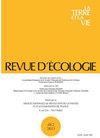农村山区红草种群的生态学。(Insectivora蝽)
Q4 Agricultural and Biological Sciences
引用次数: 28
摘要
Crocidura russula仅限于其分布范围北部的人类住所附近以及中欧和西欧的山区。为了更好地了解这种分布的原因,在一个农村山区栖息地(海拔750米)研究了一个种群,在那里几乎只在人类住所附近发现了这个物种。该研究在2000平方米的面积上进行,为期20个月,采用了活体捕获和放射性跟踪。一年中,鼩鼱的数量、分布和行为都有很大的不同。在夏季,它们主要栖息在有茂密草本覆盖或灌木植被的地区;它们主要活跃在地面,在凋落物中。在秋天,环境条件的变化(温度的降低,草本植被的下沉,雪的存在)产生了重要的能量问题。那时,鼩鼱逐渐在堆肥堆和建筑物周围和内部变得更加活跃。这种环境的小气候温和,猎物众多。冬季种群数量减少(在冬末达到最低水平),只由频繁出没于这些地点的鼩鼱组成。观察到的空间分布是越冬鼩鼱对人类住所及其周围环境的能量依赖的结果。这种依赖性可能与该物种的生理特性有关。在勘探区内,只有鼩鼱会定期利用人工栖息地;冬季种群的社会组织可能有利于该物种在农村山区环境中的维持。其他本地的飞蛾只偶尔在人类住所附近被观察到。本文章由计算机程序翻译,如有差异,请以英文原文为准。
Ecologie d’une population de Crocidura russula en milieu rural montagnard. (Insectivora, soricidae)
Crocidura russula is restricted to the vicinity of human dwellings in the northern parts of its range and in the mountain regions of Central and Western Europe. In order to better understand the causes of such a distribution, a population was studied in a rural mountain habitat (750 m above sea level), where the species was found almost exclusively in the neighbourhood of human dwellings. The study was conducted on a 2000 m2 area, over a period of 20 months, by live-trapping and radioactive tracking. The abundance, the local distribution and the behaviour of the shrews vary greatly throughout the year. In summer, they chiefly inhabit areas with a dense herbaceous cover or shruby vegetation; they are mainly active at ground level, in the litter. In autumn, changes in the environmental conditions (lowering of temperatures, subsidence of the herbaceous vegetation, presence of snow) create important energetic problems. At that time, the shrews gradually become more active around and inside compost-heaps and buildings. The microclimate of such environments is mild and prey are numerous. The winter population is reduced (reaching its lowest level in late winter) and consists only of shrews frequenting these sites. The observed spatial distribution is the result of the energetic dependence of the wintering shrews on human dwellings and their surroundings. This dependence is probably related to the physiological characteristics of the species. In the prospected region, Crocidura russula is the only shrew which regularly takes advantage of man-made habitats; the maintenance of the species in the rural mountain enviroment is probably favoured by the social organization of the populations in winter. The other native Soricids are observed only occasionaly int he neighbourhood of human dwellings.
求助全文
通过发布文献求助,成功后即可免费获取论文全文。
去求助
来源期刊

Revue D Ecologie-La Terre et La Vie
环境科学-生态学
CiteScore
0.80
自引率
0.00%
发文量
0
审稿时长
>36 weeks
期刊介绍:
It aims at publishing rapidly online, in French or in English, innovative studies covering all aspects of ecology : e.g., conservation biology ; ecology of organisms, populations, communities and ecosystems ; sensorial, physiological, behavioural and evolutionary ecology, etc.
 求助内容:
求助内容: 应助结果提醒方式:
应助结果提醒方式:


